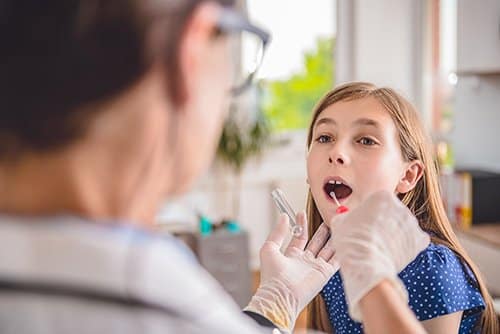This blog is part of a series of blog posts designed to serve as a quick reference guide. Each will focus on a sudden injury or illness and is designed to help you make an informed decision on a plan of action when the unexpected happens.
Strep throat is an infection of the throat and tonsils caused by bacteria called Streptococcus pyrogenes that live in the nose and the throat. It is more likely to develop in people who have spent time in close contact with someone who has strep throat or a crowded place. It is most common in children and teens, but adults can also get it as well.
How do I know that it’s strep throat and not a cold or other virus?
The main symptom of strep throat is a sore throat that comes on suddenly. The throat feels raw, and it hurts to swallow. While colds and other viruses can also cause a sore throat, they are usually also accompanied by a runny nose.
Strep throat is also likely to cause these other symptoms as well.
- A fever of 101 F or higher
- Red, swollen tonsils
- White patches in the throat
- Tiny red spots on the roof of the mouth
- Swollen, tender glands in the neck
- Appetite loss
- Stomachache
- Headache
- Nausea, vomiting
- Rash (rare)
When should I seek medical care?
You should call your doctor if you or your child has the symptoms above. Because strep throat is a bacterial infection, it can be quickly and easily treated with prescription antibiotics.
How is strep throat diagnosed?
Strep throat is usually identified with a rapid strep test. The doctor gently holds down the tongue with a depressor and uses a cotton swab to take a little bit of mucus from the back of the throat. You will get the results in 20 minutes or less. If strep bacteria is present, the doctor will prescribe antibiotics.
How should I treat strep throat at home?
- Take the antibiotics and any other medications prescribed by the doctor as directed. Even if you start to feel better, do not stop taking the antibiotic.
- Rest.
- Drink plenty of water or other clear fluids to prevent dehydration.
- Ibuprofen or Acetaminophen can be used as directed to help with pain and to lower fever.
- Stay at home for at least 24 hours after starting antibiotics.
- Gargle with salt water 3-4 times a day or as needed. To make a saltwater mixture, completely dissolve ½ – 1 teaspoon of salt in 1 cup of warm water.
- Try drinking warm liquids such as tea or broth to ease throat pain. Or, try sucking on a popsicle.
- If other family members start to have symptoms of strep throat, they should be tested.
- Be sure not to share cups, silverware, or other personal items while you have strep throat.
- Get a new toothbrush after the 3rd or 4th day of antibiotics when you are no longer contagious to avoid reinfection.
When should I seek additional medical care?
- The glands in the neck continue to get bigger
- A rash, cough, or earache develops
- You cough up a thick green, yellow-brown, or bloody liquid
- You have pain or discomfort that does not improve after taking the medication
- Fever continues after taking the medication
- You’re concerned about dehydration
You should seek immediate medical care if:
- You have shortness of breath or breathing difficulty.
- You have changes in your voice or begin drooling.
- Your joints become swollen and painful.
- Your neck becomes swollen or stiff.
- The skin on the neck is red and tender.
- You develop new symptoms such as vomiting, a severe headache, or chest pain.
Both Integrity Urgent Care locations are open daily from 8 am – 8 pm. Walk-ins are encouraged, and appointments are never necessary. We’re only a phone call away if you need more information.
Sources: https://www.webmd.com/oral-health/understanding-strep-throat-basics#3


